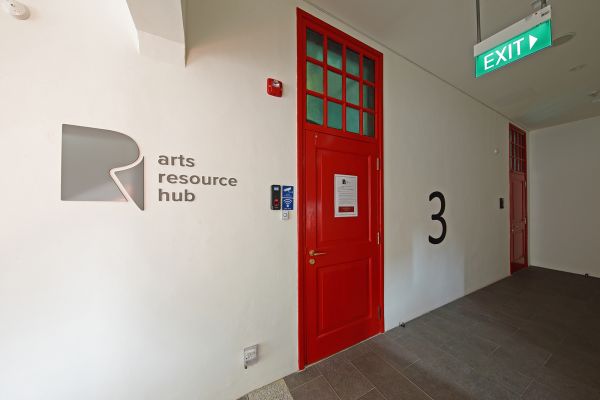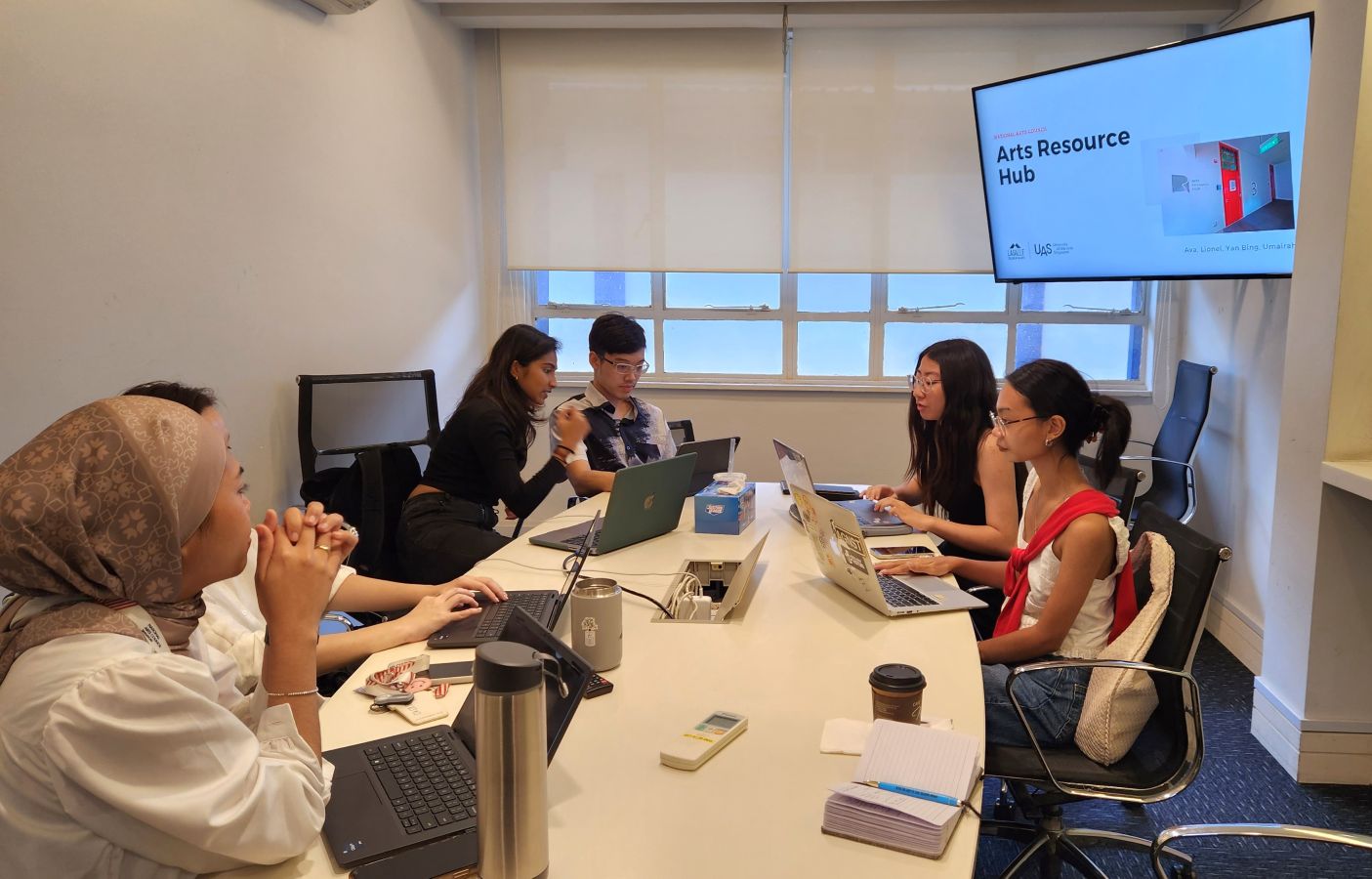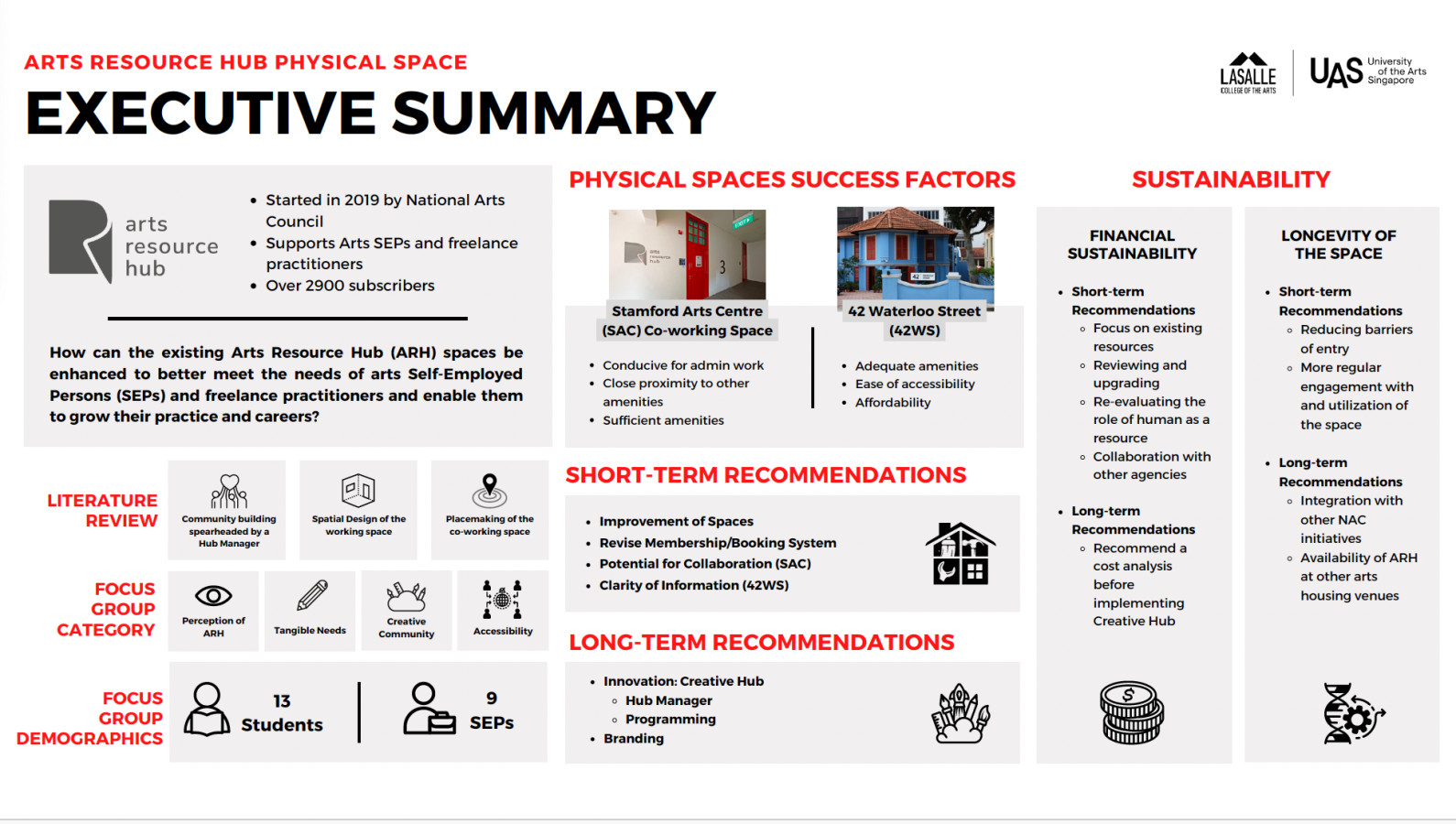
Enhancement of the NAC Arts Resource Hub spaces for Self-Employed Persons (SEPs)
Project Gallery

NACxLASALLE ARH team at the National Arts Council.
LASALLE BA Arts Management students presenting their preliminary findings to the NAC ARH team

Executive summary
A summary of the overall project process, methodology, findings and recommendations.
Context and problems
How can the existing Arts Resource Hub (ARH) spaces be enhanced to better meet the needs of arts Self-Employed Persons (SEPs) and freelance practitioners and enable them to grow their practice and careers?
The above should include, and is not limited to the following areas of consideration:
• Use or purpose of the 3 spaces (e.g. what are arts SEPs key needs, do they still need co-working spaces for administrative purposes, is there a growing preference for flexible spaces and what facilities should be included etc)
• How to make the spaces more accessible (e.g. easy booking/checking of availability etc)
Background
Established in 2019, the ARH was set up with the objective of building professionalism, self-reliance and resourcefulness of arts practitioners. Access to Physical Spaces was one of the 6 focus areas highlighted then. The lack of access to affordable spaces was a concern that was raised in the series of 24 focus group sessions conducted in 2018 to gather feedback from the community.
The 3 spaces under the ARH are designed to cover a variety of the needs of arts SEPs, including administrative, networking and incubation of works.
- ARH Co-Working Spaces: Two co-working spaces at GAC and SAC to provide basic administrative spaces for arts SEPs
- 42 Waterloo Street: A small-size arts venue with a black box, rehearsal studio and meeting room for arts SEPs to discuss, create, incubate and present works.
COVID-19
With the onset of COVID-19 just after the spaces were launched, working habits of people was drastically changed to include working virtually as a norm. Both spaces were temporarily closed multiple times starting with Circuit Breaker on 6 April 2020.
Key Challenges Today
General:
- Relatively low utilisation (some feedback cited were due to location – especially for GAC, lack of awareness of the spaces and existing spaces do not meet existing needs)
- Non-intuitive system to book and access the ARH spaces (e.g multiple steps to retrieve the passcode and manual checking if they are ARH subscribers, hirers are required to fill up lengthy booking forms for 42WS)
- Limited awareness of the spaces and resources available at the ARH venues
Specific to 42 Waterloo Street:
- Lack of brand presence. The space are at times regarded as the space of Centre 42 Limited who is an arts tenant of 42 Waterloo Street.
- Capacity constraint. The facility are fairly small with the biggest facility able to hold up to maximum only 80 pax.
- Long and strenuous booking process. Hirers are required to fill up detailed information of the event for every booking made at the site.
Specific to Co-Working Spaces:
- Conduciveness of the co-working spaces for group meeting vs individual work (had some feedback from users regarding noise levels in SAC)
Team Members and Roles
Lionel Fong: Client liaison officer, researcher (literature review), focus group designer, interviewer
Ava Kannan: Researcher (literature review, thematic analysis), focus group designer, interviewer
Lim Yan Bing: Team scribe and manager of timeline, researcher (literature review), data visualiser and analyst, focus group designer, interviewer
Umairah Muhammad Nasr: Researcher (literature review), focus group designer, interviewer
Key Goals and Objectives
In order to discover how the existing ARH spaces can be enhanced to better meet the needs of arts Self-Employed Persons (SEP), the group proposed the following hypothesis and research questions:
A highly utilised creative hub that is beneficial and effective needs to be easily accessible, have a community spirit, and provide its members with a sense of belonging.
Key Research Questions
- Is community bonding identified as a need for the majority of SEPs in Singapore?
- What are the positive and negative perceptions of ARH spaces?
- How can placemaking and community bonding enhance the brand of ARH?
Project Budget
n/a
Project Timeline
January - February: Preliminary research of existing data, Literature review, survey of co-working landscape in Singapore
February - March: Focus groups and interviews, organisation of data
March: Analysis and report writing
April: Submission of final report and recommendations
Project Methodologies
Mixed method, incorporating literature review, observation and participation, focus groups and interviews.
- Focus Group Discussions with SEPs and ARH users
- Interviews with comparable co-working spaces in Singapore
- Thematic analysis of findings
Project Research Insights
Focusing on just SAC and 42WS, the findings yielded that although both facilities were meeting certain needs of users, there were limitations to both spaces that affected functionality, and further issues related to branding and awareness, and ease of booking.
Recommendations:
A. Short-term
i. Improve Existing SAC ARH Physical Spaces
As SAC’s co-working space was found to be more suitable for individual work it is recommended that the collaborative function be removed, making the SAC ARH a dedicated and exclusive space for quiet individual work. This entails rethinking of spatial design as well as a revised membership system for access and collaborations with other government agencies to offer shareable resources as further identified as needs through the FGDs.
ii. 42WS: Reiterate Purpose and Facility Improvements
While findings for 42WS celebrates its services and rates, it also identified the primary barrier of entry to be the ineffective communication of its purpose and processes, amplified with the extensive and complicated booking system. To address this, physical adaptations are proposed to create more flexible services, the booking system should be revised, and a communication strategy is needed with clarity of purpose and policies of use.
B. Long-term
i. Cultivation of a Creative Hub
A community-led creative hub, facilitated by a dedicated Hub Manager who acts as a community builder and resource provider. Supported by the NAC, the Creative Hub is proposed as a decentralised and community-led initiative with regular events conceived and implemented by the community.
Project Deliverables and Outputs
A report (either in PPT or pdf format, up to 10 pages), which includes the following:
i. Survey findings on arts SEPs needs in related to physical spaces
ii. Ideas and solutions for enhancing the spaces (both the Physical space and Management and/or access to the space)

